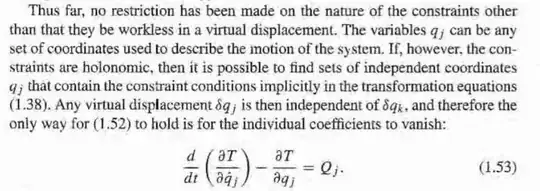If a constraint on the motion of the system are holonomic, by definition of 'holonomic', the only thing it restricts is the position of the system to a subspace of lower dimension (subspace of the whole unrestricted space of the old coordinates). A set of new coordinates (which has fewer number of them than the old set) can be then introduced to describe position in this subset, free of any remaining constraint. So, any continuous trajectory entirely in the subspace is possible. Think of how constraining a mass point in 3D space to a surface of a sphere allows us to introduce 2 new coordinates of the point, which we are then free to continuously change in any way (latitude and longitude).
However, if the constraints on old coordinates are not holonomic, the restriction on the possible motion is not simply a restriction of its position to a lower dimensional subset of the old space. The typical example is restricting things such as how fast and by which path the system may change its position. While the set of possible positions may be unrestricted, the possible trajectories connecting those positions in that set are restricted and so the differentials of any valid set of coordinates $q_i$ will be somehow restricted, either mutually or by some time-dependent condition. Think of a marble made of rubber, bound to always touch a desk, with no sliding possible. For any pre-selected contact point on the desk and any angular orientation of the marble, it can be put in there while obeying the non-sliding constraint at every step, just by rolling it cleverly. But it cannot be done "directly", by simply translating and rotating in the most obvious way, because that could require sliding. Instead, it has to be rolled back and forth appropriately to acquire the right angular orientation, while also moving the touch point to the destination. This means the possible trajectories connecting two possible positions are constrained, not every trajectory is possible. The constraint is that the speed of the lowest point always has to be zero, which translates to a constraint on the simultaneous values of variation of position on the plane and variation of the angular variables.
If there was a complete set of independent coordinates for a system, there wouldn't be any restriction of the above kind on the trajectories, because, well, the coordinates would be completely independent of anything. Such system thus could not be having nonholonomic constraints.
